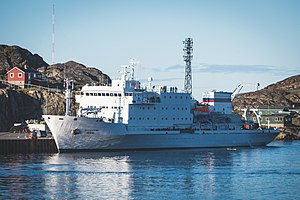 Akademik Ioffe off the coast of Nova Scotia, Canada
| |
| History | |
|---|---|
| Name | Akademik Ioffe |
| Operator | Shirshov Institute |
| Port of registry |
|
| Builder | Hollming, Rauma |
| Yard number | 266 |
| Laid down | 27 February 1987 |
| Launched | 29 August 1987 |
| Completed | 9 February 1989 |
| Identification |
|
| Status | In service |
| General characteristics [1][2] | |
| Tonnage | |
| Length | 117.17 m (384 ft 5 in) |
| Beam | 18.22 m (59 ft 9 in) |
| Draft | 5.90 m (19 ft 4 in) |
| Installed power | 2 × 6CHN 40/46 (2 × 2,576 kW) |
| Propulsion |
|
| Speed | 16.0 knots (29.6 km/h; 18.4 mph) |
| Capacity | 117 passengers |

Akademik Ioffe is a research vessel, named after the Soviet physicist Abram Fedorovich Ioffe.
Built in 1988, the vessel has a displacement of 6,600 tons, and a length of 364 ft (111 m).[3] Akademik Ioffe and Akademik Sergey Vavilov were built as a joint project. Both ships feature a vertical shaft about two meters in diameter, which opens from the main deck into a special room, from which an acoustic receiver or a transmitter can be lowered to below the waterline by means of a winch. The vessels were used for experiments on the long-range propagation of sound in the ocean.
The vessel belongs to the Institute of Oceanology. P. P. Shirshov, of the Russian Academy of Sciences.
She was chartered by One Ocean Expeditions until 2019.[4]
- ^ "Akademik Ioffe & Akademik Sergey Vavilov Ship Information Guide" (PDF). warren-macdonald.com. 2012. Archived from the original (PDF) on 4 March 2016. Retrieved 21 July 2012.
- ^ "Akademik Sergey Vavilov (860738)". Register of ships. Russian Maritime Register of Shipping. Retrieved 19 April 2013.
- ^ Struzik, Ed (29 August 2018). "In the Melting Arctic, a Harrowing Account from a Stranded Ship". Yale School of Forestry & Environmental Studies. Retrieved 10 September 2018.
the 364-foot Russian cruise ship, Akademik Ioffe
- ^ "Russians Pull Charter Deal from One Ocean Expeditions". 22 May 2019.